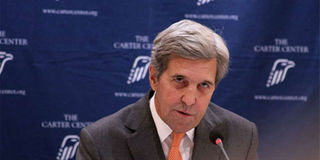Challenges facing election observation in Kenya today

The Carter Center EOM co-leader John Kerry speaking at a press conference at the Radisson Blu Hotel on August 10, 2017 where he commended an election that was later nullified by the Supreme Court. Election observers must confront the challenges facing modern-day observation and monitoring. PHOTO | EMMA NZIOKA | NATION MEDIA GROUP
What you need to know:
But the architects and framers of election observation checklists must now confront the challenges facing modern-day observation and monitoring.
Furthermore today’s election observers must be properly trained to examine and detect cases of illegitimate documentation.
An ill-equipped observer may not easily notice subtle cases of misconduct, including the presence of more than one form existing for single polling station or constituency.
The Supreme Court heard, determined and ordered Kenyans back to the ballot through the nullification of the August 8 presidential election.
That was the easy part.
The headache was effectively transferred to the other various stakeholders in Kenya’s electoral processes.
First, the presidential candidates were thrown back to the trenches of political campaigns.
RESUMED
The voters resumed their bemused roles of cheering and at times, even jeering the political protagonists.
The Independent Electoral and Boundaries Commission (IEBC) was dispatched to repair the irregularities and illegalities which were fingered in the Supreme Court judgment.
The election observation groups, both local and international, did not escape scrutiny, too, mostly because of their favourable preliminary reports.
And this means that the local and international election observation groups have their work simply cut out for them.
ELECTION MANIPULATION
From the corpus of the Supreme Court verdict, it plainly emerged that today’s election observation goes beyond the simplistic approach of witnessing problems like potential voters being turned away because of dysfunctional registers or inadequate election materials etc.
Election manipulation has evolved and become more complex and is executed with such subtle politeness that any untrained observer would be lost in the woods.
The August 8 elections reached the level where nobody stopped anybody from voting.
And nobody stopped anybody from counting the votes.
CHALLENGES
And yet, according to the findings of the Supreme Court, what happened thereafter would make a classic fictional movie, if only we were not dealing with such serious stuff like democracy, the sovereign will of the people and their right to choose their leaders in a free, fair, transparent, peaceful and credible process.
But the architects and framers of election observation checklists must now confront the challenges facing modern-day observation and monitoring.
For instance, today’s observation checklists must capture the following categories of irregularities and illegalities which were thoroughly canvassed in the Presidential Petition.
Unstamped and unsigned results forms, formed a major part of the puzzle that refused to unravel during the presidential election petition proceedings.
NOT ADD UP
The puzzle was compounded by the fact that the number of votes cast, uncast votes, disputed votes and rejected votes did not add up in some instances.
And just how did we end up with improperly filled forms?
Of course, if the Supreme Court proceedings qualified as a source of cheap entertainment, then it was capped by the finding that Kenyans went to the August polls, complete with a full basket of ungazetted polling stations and ungazetted returning officers.
It is, therefore, quite revealing that if, for instance, the same presiding officers would sign election results for up to 30 polling stations — and if at all Forms 34As were filled in similar handwriting — then election observation groups need to definitely revise their observation approaches, since it is highly unlikely that such openly criminal acts would be executed in the full glare of the public.
LTO APPROACH
And it becomes more challenging especially for election observation groups that do not adopt the Long Term Observation (LTO) approach, because they would be limited and incapacitated when it comes to knowing whether the election officials were all adequately trained before deployment.
Without an effective LTO programme, it would be difficult for observers to even notice the replacement of election officials.
And definitely, the era of roaming election observers, who could drive around in luxurious four wheel drive vehicles, and paying courtesy calls to polling stations is literally over.
The LTO approach also enables observers to familiarise themselves with the electoral areas so that they can, for instance, tell if entire wards and/or constituencies have been left out of the forms for tallying of the votes.
TRAINED
Furthermore today’s election observers must be properly trained to examine and detect cases of illegitimate documentation.
An ill-equipped observer may not easily notice subtle cases of misconduct, including the presence of more than one form existing for single polling station or constituency.
Today’s election observers also need to be tech-savvy, if they will be expected to observe elections within jurisdictions that have gone fully digital or partially digital like Kenya.
The writer is public policy analyst at Public Research and Development Consultants. [email protected]




